| Mrs
Doris Taylor, John's widow, writes: "I
know I was married to a very remarkable and wonderful
Christian man. He was given the Freedom of the City
of London and many other things. He won an Entrance Scholarship to Cambridge to study architecture, but he was destined to take another path which lead him to Hawker's Aircraft. He talked of his young life at Soham Grammar School with great pride." |
 from the 1937 School photo |
At Soham Grammar School, some of John Taylor's progress can be tracked from mentions of him in the Soham Grammarian:
Lent 1937: Scientific Society report: "On December 7th [1936] the meeting took the form of a conversazione ... J Taylor and J Atkin gave a colourful display of pyrotechnics ... This term our first meeting consisted of the reading of five interesting papers .. "The Routine of an Airport by J Taylor."
The same issue, reporting on the Royal
Drawing Society's Examination June 1936 results:
Division II Honours .. J Taylor
Division III Honours .. J Taylor
In the Autumn 1937 issue John was among those reported to have competed their full School Certificates
Autumn 1937: "A VISIT TO
SANGER'S CIRCUS
On Thursday, October 14th, a party of about seventy boys,
under the supervision of Mr. Crouch and Mr. Johnson, paid a
visit to Sanger's Circus, at Ely, after school. The Circus
was quite large and entirely self-contained. There was an
exceptionally fine menagerie, with many animals which are not
usually found except in large zoos; they included a wallaby,
a small species of kangaroo, and a fifteen-weeks-old monkey.
The show itself was very good for a travelling circus,
despite the number of parts that some of the performers had
to play. The first act on the programme was an outstanding
display by a German lion-tamer, Clemens Merk, who obviously
had complete mastery over his seven huge animals, even though
they were described on the bills as "The Untamable
Lions," and were that afternoon in a bad humour. One of
his best feats was to make Suliman, the largest lion of all,
stand on two pedestals and allow one of the five lionesses to
jump over it.
The usual troupe of clowns were more than usually funny, especially Pimpo and Spider, a long and lanky fellow who confounded all the great mathematical minds of the world by proving that three times three are ten. Pimpo showed himself to be not only a very comical clown, but also a remarkably good horseman and trapeze artist, although in the last two accomplishments he tried to give the impression that he needed " Learner " plates, a harder thing to do than the actual riding and acrobatics. A well-trained elephant called jumbo proved himself proficient in emulating Bastin by kicking an outsize in footballs at a net. Members of the audience were invited to come and keep goal against jumbo, but no one accepted the invitation, probably because they were afraid that if they stopped a shot they might offend him, and an elephant never forgets.
The next act on the programme was the six Royal Cream Horses. These horses gave an excellent display, and kept in line like a row of soldiers, with the largest in front and each successive horse a little smaller than the one in front. The funniest horse of all, however, was the one trained by Pimpo: it could sit down on four legs, dance, and carry its hind legs, pick-a-back, on his shoulders. This, as you have probably guessed, was a property horse formed by two men. Pimpo then returned and amused everybody by turning somersaults over several men. He began with one man and afterwards called out musically, "And now we'll have another one." He was assisted in this act by Spider, who was dressed as a Chinese Mandarin, and was wearing a small round hat with a gigantic feather stuck in it. There were many other acts too numerous to mention, including a waltzing horse, trapeze artistes, and a man who walked down and up a series of steps on his hands. In fact, the whole performance was very good and the band excellent. A good time was had by all, and thanks are due to Mr. Crouch and Mr. Johnson for organising such an interesting trip.
Spring 1938: John's paper on 'Poison Gases and Gas-masks' was one of four read at the March 7th meeting of the Scientific Society.
Spring 1938: "IS THE WORLD
GOING MAD?
Nearly every nation is now taking part in a desperate race
for rearmament. More especially is this so with the more
civilised nations of Great Britain and Germany. These two
great nations are spending millions of pounds a year on
Naval, Army and Air Force weapons. Great Britain says that
she is rearming purely for defence; Germany says nothing. The
only sober nation in this rearmament turmoil seems to be the
land which is always associated with utter madness - the
United States of America. This huge country is spending only
moderate sums of money on arms, and is instead spending it on
humane work such as the relief of her flood-stricken
inhabitants. The British Government announced last year that
£200,000,000 was to be spent on new weapons. This sum is not
going to be realised by the more wealthy classes, but is to
come from taxing the poorer people. The English people would
not mind spending moderate sums of money on defence forces,
but although they are forced to pay taxes far in excess of
any other European nation, they do not see any return for the
loss of their hard-earned money.
Hardly any new weapons appear, although we are told that the armament factories are working overtime. When the weapons do appear they are seen to be obsolete and almost useless. For example, Germany is turning out several of what are termed pocket battleships, small warships with very high speeds. Great Britain continues to produce warships of the same type as the King George V, which was launched at the beginning of the Great War, and can make only about thirty knots. In nearly every nation there are enough gas-masks for every person to have one. In England, which has one of the finest gas-masks in the world, we are told that they are being produced by the thousand, but hardly anybody of the civil population has ever seen one.
America has a new Martin bomber, and Germany has a new Heinkel light bomber which have speeds well in excess of 300 miles an hour. Although we have had planes which will travel at much higher speeds than this for years, they are only just being put into production. Indeed, the standard R.A.F. heavy bomber at the present time is the Handley Page Heyford, which has a maximum speed of 180 m.p.h. These examples show the disregard for public safety by our Government up to about a year ago.
Now every nation of the world is beginning to distrust the others. Many think that in time Germany will get so strong that she will endeavour to retake her colonies, which she considers were stolen from her at the end of the War. This may happen, but it is as much the fault of other countries as Germany. The present division of colonies is very one-sided, and a great country like Germany urgently needs raw materials produced in places like Samoa and Tanganyika, which were mandated to England, and the Cameroons, which were given to France.
The ultimate result of all this rearming seems to be that one nation will think itself to be stronger than any other and will begin a war. This has happened in the past with disastrous results to all concerned.
It is thought that three or four thousand years ago the ancient Chinese had wonderful scientists and professors. They are thought to have known all the modern inventions such as the power of flight and explosives, probably almost as perfect as any we have to-day. Then war came, and all went mad with the lust of destroying everyone and everything that came in their way. This had a degrading moral effect, and people who had been highly civilised became nothing but savages. They began to depend for food on the animals that they killed. They used stone and wooden weapons, as they had lost the art of metal-working. They then went back to live in the trees, as all houses and buildings were destroyed. They had no proper clothes left, and wore skins of animals as substitutes.
In time, however, people began to develop their minds and grew to think more about the lost pleasures of life; they continued to develop until we see other civilisations in the making. They changed their dwelling-places from trees to caves, from caves to mud huts, from mud huts to wooden huts, and then to brick or stone houses. Their methods of living improved, and with these their characters, and so they built themselves a mighty empire. The people that I am refer ring to are of course the Romans. Then they owned so much that it went to their heads, they became lazy and lived in palatial houses. Thus they lost their original fitness, and so, when attacked by barbarians they were swamped, and, mixing with the barbarians, they became like them, and another great empire was finished.
Now we have our great Empire, the greatest ever. We must take care that we do not get over-confident in our strength, and become, like the Romans, lazy, or like the ancient Chinese, self-destructive. If we were suddenly attacked by another nation, perhaps more mighty even than ourselves, the whole of Europe would probably be mixed up in a war, and the lust for blood would come over us all, and we should send our mighty bombers, battleships and armies to smash places and people to smithereens. The bombing aeroplanes would then come from that country and bomb all our towns to pieces. This sort of thing may happen if people and politicians make armaments the chief idea in their minds, and just build them and forget other methods. What we must not forget is a lesson that should be taught by the old Roman games in the arenas. The " Retiarius " armed only with a net and trident more often than not could beat a mighty gladiator clad in armour and armed with the deadly Roman short sword and shield.
If we are not to go mad, as did the ancient
Chinese, we must keep fit and well armed, but not too well
armed. We must also not try to be top dog in everything, as
pride has a downfall.
J. W. R. TAYLOR VU.
Summer 1938: Form V Lower Prize: J Taylor
The Royal Drawing Society's Examination June 1937: Honours in
Dvisions IV, V, VI : J Taylor
Autumn 1938: School Certificate: J Taylor:
J W R Taylor was awarded an Isle of Ely Intermediate
Scholarship.
Scientific Society: J Taylor gave one of four papers, his was
on 'Aerostats' (lighter than air aircraft)
Autumn 1938: THE POST OFFICE FILMS
On Wednesday October 5th [1938], at the invitation
of the operators of the mobile film unit of the Post Office,
the entire School visited the Church Hall, Soham, to see a
set of films dealing with the everyday activities of the
British Postal Staff. There were five films, the titles of
which were : " Weather Forecast," " The Fairy
on the Telephone," " In Two Worlds," "
The Dial Telephone," and " Night Mail."
The first film showed how the weather forecasts were received, mapped and communicated to the various broadcasting stations, including the B.B.C., and Croydon. It began by showing the wind indicators of the Coastguard Stations, by which barograph records are made, the variations on the latter showing whether bad weather can be expected. The pressure, wind movements and temperature are then communicated by telegraph to the Central Office in London, where all reports are noted and a special weather map prepared. From this map the meteorologist makes a report on whether a storm can be expected or not. If a gale is imminent a special message is sent to the B.B.C. and a gale warning is issued. The film ended by showing the effect that a gale has upon sea and air services, and how gale warnings are received by wireless.
" The Fairy on the Telephone " was a totally different type of film. Instead of being about a specialised work of the G.P.O., it pointed out the faults made by an ordinary telephone subscriber. These faults were pointed out not without humour. The film depicted a professor with ancient telephone directories which ought to have been discarded. One was so old that it was inhabited by a family of mice, which had chewed away the inside. Using old directories was not the only fault shown. Requests were made that the telephone receiver should always be replaced, that time should not be wasted by repeated " Hello's," and that the telephone should be answered as quickly as possible. Perhaps the funniest episode was when a schoolboy, with an intensely dirty face, endeavoured to telephone with a mouthful of sweets, the speech sounding like a confused subterranean mumbling. The " Fairy," or ghost, as she was transparent, gently pointed out the faults, to the profound astonishment of the subscribers.
" In Two Worlds," by J. B. Priestley, was quite short compared to the others, and showed how the frontiers of the old world had been conquered by the freedom of the unlimited telephonic world. Switzerland was taken as a typical example, being totally hemmed in by the old frontiers, but, because of the telephone and other communications, this small State has found freedom, without frontiers, as the telephone knows no boundaries.
" The Dial Telephone " was a film about a very technical subject, but was clearly described in language which even the most ignorant " Fen Tigers " could understand. The film showed the whole working of the dial telephone from the moment that the subscriber turned the dial to the moment the message was put through.
The last film, " Night Mail," was the longest and one of the most interesting, as it showed how the mails were picked up by the L.M.S. Postal Special on its run to Scotland and then sorted, put into pouches, and released into nets at wayside stations.
The whole show was well produced and was
very much enjoyed by the boys and staff. Our thanks are due
to all concerned for a very pleasant hour.
J. W. R. TAYLOR, VIB.
Autumn 1938: MORAL RE-ARMAMENT
On Monday, October 31st [1938], the Vicar of Soham,
the Rev. P. F. Boughey, once more paid us the honour of a
visit, bringing with him, as before, a distinguished friend
to lecture to us. This year he introduced to us the Rev. S.
J. A. Evans, Vicar of Christchurch, who was once Precentor of
Ely Cathedral and is now engaged in Mission work in Soham.
Mr. Boughey was the first to speak. He
introduced Mr. Evans and explained briefly his present work
in Soham. Mr. Evans began his very interesting talk by
explaining the difference between a missioner and a
missionary, and his work as the former. He said that he hoped
the coming generation would act as missionaries or messengers
and spread the Word of God throughout the world. He then
humorously called to mind that very interesting little verse
about a missionary :
" Once a little Cassowary, On the plains of Timbuctu,
Ate a Christian missionary, Bible, prayer book, hymn book
too."
He said that the missionaries had a very hard time in the old days when they had to brave the cooking-pots of the Solomon Islanders. People seemed to forget that missionaries had just as hard a task now in the world of growing militarism. Mr. Evans continued: it is hard for the Christian Faith to exist in this modern world. It has vanished almost entirely in dictator-ruled countries such as Russia and Italy, and has been replaced by faith in the State. Before the Revolution in Russia the country was in a state of moral and financial crisis. Then the Revolutionary Party had arisen with new ideas for the people to believe in. The main idea was that the State was first in all things.
Mr. Evans said that the results of this intense nationalism could be seen in the recent crisis when nations were ready to fly at each other's throats. If all nations were to believe in Christianity this sort of thing could not happen, as all nations would be friendly towards each other. What was needed in our world was not military re-armament - guns, guns, and still more guns - but moral and spiritual re-armament and a return to religion.
When Mr. Evans had finished, the Headmaster
rose and thanked him on behalf of the School, and the boys
and staff showed in the usual manner their appreciation of
the very interesting talk.
J. W. R. TAYLOR, VIB.
Spring 1939: John provided an account of a presentation of the play Tobias and the Angel by the Martin-Harvey Itinerant Theatre and Miniature Ballet Company: 60 boys accompanied by Mr Lait and Mr Riley went to the High School, Ely for this.
Summer 1939: Speech Day was on Wednesday 17th May 1939, at which Major-General Sir Hereward Wake C.B., C.M.G., D.S.O. presented the prizes. John Taylor received a Form V Upper Prize (awarded on the results of the School Certificate, 1938: credit in English, History, French, Mathematics, Chemistry and Art)
| Autumn 1939:
AN ODD ODE Oh ! How I wish some clever folk Could write an original radio joke ; Or a man with a really first-class brain Think out new rhymes for a song refrain. We are tired of jokes that Noah told in the
Ark, We all know the chicken crossed the
road. |
Augustus Caesar in A.D. three Knew all the rhymes of the B.B.C. He knew that a glorious night in June Was ideal for love beneath a moon. Why doesn't somebody write a song Oh! How I wish some clever folk J. TAYLOR, Form VIA. |
Spring 1940: Played for the School against the Old Boys at rugby: School 6 - OB 13, provided work for the Art Club, was among those Scouts gaining their National Service badge, provided an article from the Philatelic Society, recording that he had given talks; Jan 25 1940 "Stamp Collecting in General", suggestions were made for members to make their own albums and specimens of home-made albums were on show; February 8 1940 "Stamps in the News", illustrated with actual stamps of topical interest from Finland, France, Germany, Poland, Albania, Danzig etc.
Summer 1940: SCOUT NEWS
Scout meetings have been modified this term to a
form more in keeping with current affairs and work of
national importance. A great deal of time has been dedicated
to the collection of waste paper in the town and the result
has exceeded all expectations. In addition much time has been
spent in revising the morse code and first aid work, and the
use of stretchers and the A.R.P. Stirrup Pump has been taught
to all Scouts.
War-time conditions of food rationing and air raids have necessitated the abandoning of camping this term, but, in the early weeks, a "sausage feast" was held, in the old orchard, to the obvious delight of all.
The ordinary routine of meetings has not
been altogether neglected, and some badges have been gained.
In addition some seniors have been engaged in estimating
time, and height, and weight of objects ranging from a common
or garden bicycle to a pair of large gardening boots.
JOHN W. R. TAYLOR.
Summer 1940: THE PHILATELIC SOCIETY
Many very successful meetings have been held this
term, although the attendance figure has fallen considerably
because of the nocturnal visits of enemy raiders. All the
members are very enthusiastic and their collections have
increased noticeably in worth and interest during the last
few months. Many more stamps belonging to Mr. Crouch have
been sorted, collections have been brought for examination by
other members, varieties in the new British commemorative
stamps have been studied with interest, as well as other
activities too numerous to mention.
This War has, so far, seen the exit of
eight more stamp-issuing countries, only temporarily, we
hope. If many more countries are overrun stamp albums will
only need space for four or five countries. We hope that the
day will soon come, however, when the stamps of Poland,
Danzig, Luxemburg, and all the other countries will once more
appear in our albums.
JOHN W. R. TAYLOR, VIA.
Autumn 1940: Art Prize 1939 J.W.R. Taylor
Autumn 1940: J.W.R. Taylor is working at the office of an Auctioneer, Valuer and Estate Agent at March.
Autumn 1940: VALETE: J.W.R. Taylor: Prefect, School Certificate 1938. 1st XV Rugby, Vice-Captain Ridley, Troop Leader School Scouts.
Summer 1943: J.W.R. Taylor was among those listed visiting the school that term.
further updating to come when time permits
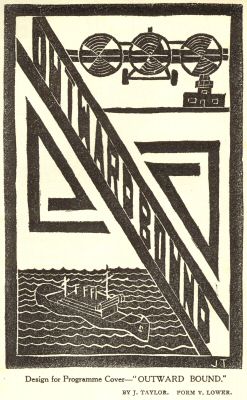 cover for a drama production Summer 1937 Soham Grammarian |
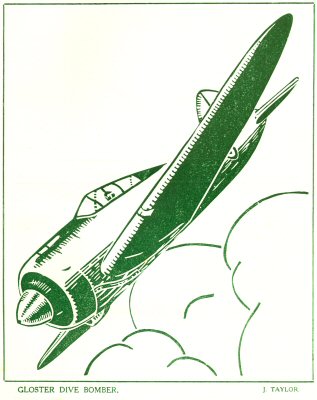 Spring 1938 Soham Grammarian |
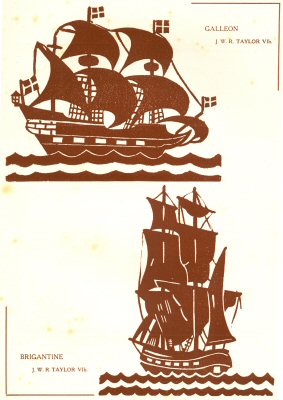 Autumn 1938 |
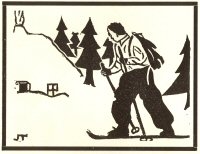 J. W. R. TAYLOR (Form VU). Autumn 1937 Christmas card design 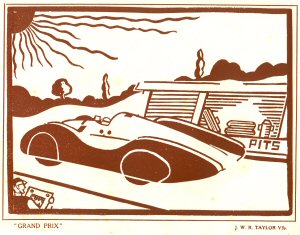 Spring 1939 |
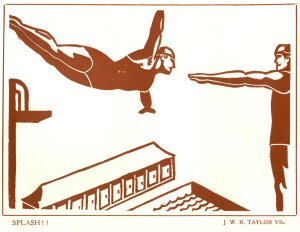 Summer 1939 |
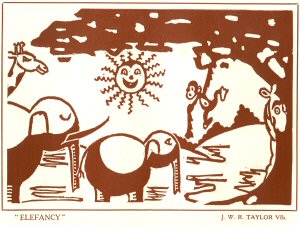 Summer 1939 |
Some cuts for a Sporting Calendar
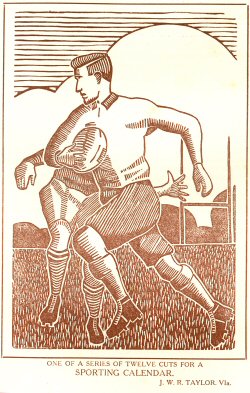 Spring 1940 |
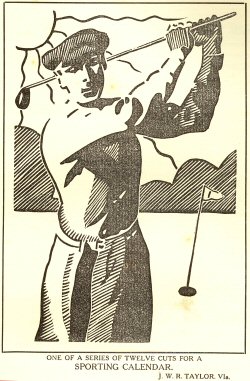 Spring 1940 |
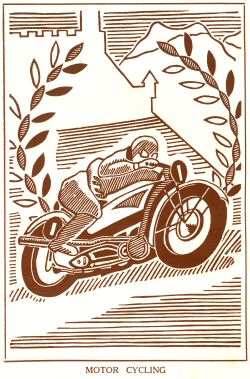 Summer 1940 |
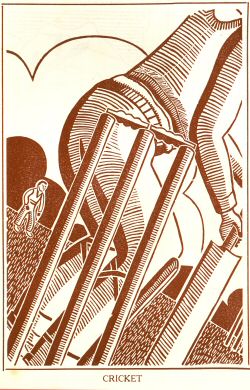 Summer 1940 |
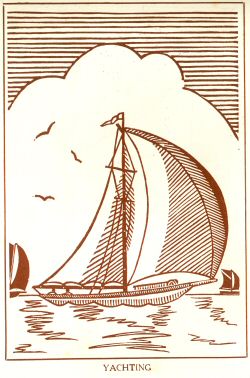 Summer 1940 |
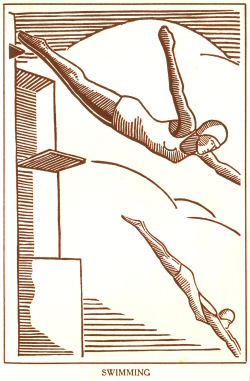 Summer 1940 |
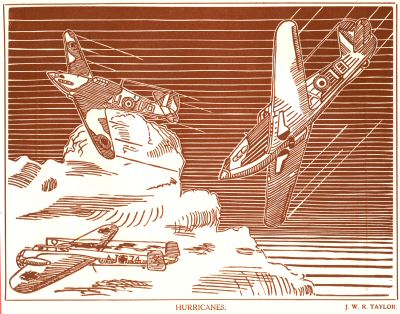
from the Summer 1941 issue, as an Old Boy
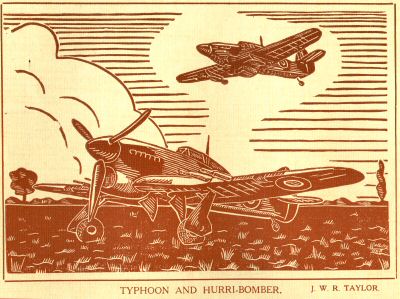
from the Summer 1943 issue, as an Old Boy
| The first
edition of CFS - Birthplace of Air Power
gained for John Taylor the CP Robertson Memorial
Trophy, awarded by the Air Public Relations
Association for "the best interpretation of the
Royal Air Force to the public" in 1959, and is
now a long out of print and costly collector's item. Thoroughly revised and updated, with additional chapters, 100 illustrations instead of the original 16, and the authentic transcript of a complete Red Arrows show among its appendices, the 1987 edition was published to mark the 75th anniversary of the founding of the CFS. |
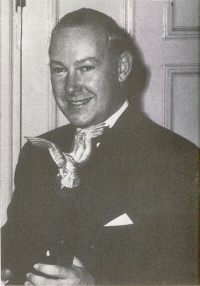 |
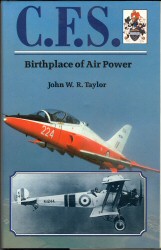 cover of the 1987 edition [CFS: The Central Flying School of the RAF] |
The Times, December 14 1999 John W. R. Taylor, OBE, former Editor of Janes All Ihe World's Aircraft, died on December 12 aged 77. He was born on June 8, 1922. An aeronautical engineer by profession, John W. R. Taylor was in charge of the aviation industry's bible, Jane's All the World's Aircraft for the thirty years 1959-89, first as Editor and then as Editor-in-Chief. In that time he created a tradition of accuracy and comprehensiveness which made the fat, information-filled volume required reading for air forces, planemakers, intelligence services and defence experts all round the world.
Under Taylor's stewardship the publication came much closer to justifying its title than it had at any time previously. Taylor expanded its coverage to include many more of the aircraft of the world than had its predecessors. And although it could never claim to track down every privately built microlite, it became notably stronger on light aviation.
Taylor also vastly expanded the scope of the technical information supplied about each aircraft and its variants. Even in the climate of the Cold War, with the heads of intelligence of the opposed ideological and military communities notoriously secretive about technical details, he maintained good relations with the Russians and eventually established at least a modus vivendi with the Chinese.
On occasions when Western speculation about new Soviet combat aircraft became somewhat fevered, he was able from his practical engineering experience to judge from photographs what the capacities of an aircraft were likely to be. When, in 1961, the Russians introduced the Tupolev Tu22 supersonic bomber (codenamed Blinder by Nato) at the Aviation Day flypast in Moscow, many Western defence analysts fearfully estimated a maximum speed in the region of Mach 2.5. From the size of its air intakes, however, Taylor came up with a much lower estimate - Mach 1.4 - which Jane's duly published. When details of the Blinder's performance eventually emerged its maximum speed was found to be much closer to the Jane's figure than to the wilder speculations.
A feature of Jane's under Taylor was the foreword he wrote for each annual edition. This contained opinions which were not necessarily what the defence establishment wanted to hear - in 1982 he claimed that the Polaris submarine-launched rnissile was "useless" as a deterrent - but they were generally calculated to make Service chiefs take note. Though not a pacifist, Taylor was a strongly religious man for whom the use of force was a last resort.
John William Ransom Taylor was educated at Ely Cathedral Choir School and Soham Grammar School. ln 1941 he joined the design department of Hawker Aircraft where, although he had almost no engineering training he soon learnt enough to make himself useful as a structural installation draughtsman. From there he progressed to a special department, rectifying design defects in aircraft as they were reported from the operational squadrons. He was involved in the conversion of the Typhoon - originally conceived as a day fighter. but relative failure in that role - into a night fighter, overseeing the installation of the necessary interception radar.
He had already begun to make a name for himself as an aviation writer and in 1947 he went as editorial publicity officer to Fairey Aviation. In 1955 he went as editorial assistant to Jane's, of which he was to become Editor in 1959. Over the next thirty years he was to transform it from merely a good book into the pre-eminent publication in the aviation world, an indispensable reference tool.
One of his greatest gifts was his penetrating observation of photographs and television pictures. When the first Soviet intercontinental ballistic missiles were paraded in Moscow he was able to give accurate figures for their dimensions - and therefore for their likely performance and payload - by estimating their length against markings painted at regular intervals on the Red Square military parade area. When the statistics for the Vostok space launcher were eventually released in 1967, they were within inches of the data that had been published in Jane's.
Aside from Jane's, Taylor was a prolific writer on all aspects of aviation, and a stream stream of books flovved from his pen, starting with Spitfire (with M. F. Allward, 1946) and ranging through Rockets and Space Travel and Best Flying Stories (both 1956) to Passenger Aircraft and Airlines (with S.H.H. Young, 1975) and his recent histories of de Haviland (with M.F. Allward, 1996) and Fairey Aviation (1997).
For a number of years, Taylor was almost a one-man band at Jane's, and he worked long and gruelling hours. But from the late 1960s he gathered a small but dedicated team round him, and their work was supplemented by the reports of correspondents throughout the world. He retired in 1989 but was appointed Editor Emeritus an continued to contribute as an adviser. He was appointed OBE in 1991, and was also a fellow of the Royal Aeronautical Society and of the Royal Historical Society.
He married, in 1946, Doris Alice Haddrick, and she survives him along with their son and daughter.
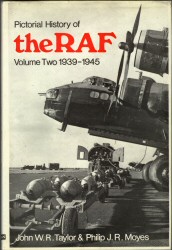 part of a three book series |
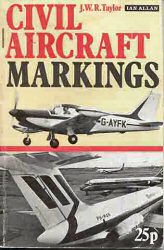 1972 edition |
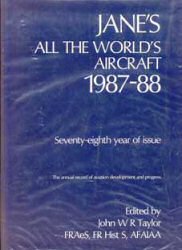 (book images not to scale) |
John W. R. Taylor, OBE A personal
tribute by Peter R March
John W. R. Taylor, who died on 12 December 1999, aged 77,
will be remembered by the aviation industry for his
editorship of Jane's All the World's Aircraft for 30
years from 1959. He brought to this annual publication a
professionalism and authority that took it onto the
bookshelves of the top ranks of the armed forces and
aerospace industry leaders right around the world. With his
aeronautical engineering background, eye for detail and
uncompromising quest for accuracy, he made Jane's
the 'aviation bible'.
Much wider than this speciality, to generations of young people who looked skyward from 1950, John Taylor was the key person who fed and encouraged their enthusiasm for aviation. My dog-eared first edition of Ian Allan's ABC of Civil Aircraft Markings, created by John in 1950 tells its own story. In the introduction he says "We do not claim that this book will tell you everything about an aircraft, but it will tell you the type of aircraft that you are looking at, who owns it and quite a lot more. Furthermore, it is not intended just for the lucky few who can get to London Airport. or- Northolt, as it will be equally helpful to the many who look up as an aeroplane passes over their homes and wonder what it is. Many who use it will devise their own methods of recording in it which registrations they have seen. If this Iittle book helps just a few people to share more fully in this great adventure of flying it will have been very worth-while". And of course it did precisely, this.
I, and many of my contemporaries underlined in CAM, the aircraft that we saw; and became 'plane-spotters', a term that John coined in that first edition. Such was the success of CAM that from 1952 it was published annually, with John as editor until 1978. It also spawned a whole raft of spotters' books in the lan Allan abc series, beginning with abc Civil Aircraft Recognition, that have been purchased by successive generations of enthusiasts. There can be no doubt that John W. R. Taylor was the 'father of peacetime aircraft spotting' and did more to encourage an interest in aviation amongst young people than almost any other person.
I am personally grateful to John for the years of friendship and encouragement that he gave to me, not least with aircraft photography. From the first publication of my photographs in early editions of CAM and subsequent abcs, to taking on a number of his titles and the creation of Military Aircraft Markings some years later, I remain indebted to him.
Following his notable progress in the
design department of Hawker Aircraft during the war, to early
work as an aviation writer and in public relations, John
Taylor was largely self-taught. As with his editorship of Jane's
which he worked on almost single-handed until it was
established, he spent many hours at his desk. After his
retirement in 1989 he continued to contribute to the book and
wrote many articles for publications around the world. He was
appointed OBE two years later.
(Airview and Military Aircraft Markings,
Feb 2000)
(US) Air Force Association Feb 2000 John W.R. Taylor, 77, editor of Jane's All the World's Aircraft from 1959 to 1989 and arguably the foremost author and editor ever on the subject of flying machines, died Dec. 12 in Kingston, Surrey, England.
He was also the author or co-author of more than 200 books. Under his editorship, the annual editions of Jane's were recognized as the most authoritative sources in the world for detailed information about airplanes. Taylor said he preferred to concentrate on the "ironmongery" of aircraft and avoid political issues. Faithful to that direction, he established a reputation for both fairness and accuracy. To some extent, he even received data from the Russians at the height of the Cold War.
From 1971 until 1997, Taylor was contributing editor to Air Force Magazine. Among his other work for this magazine, he originated Gallery of USAF Weapons, which appears each May in the Almanac issue. The gallery is now done by Taylor's daughter, Susan H.H. Young.
last updated 18 Feb 2004